Japan is home to a wide variety of flora, ranging from subtropical plants in the south to temperate forest vegetation in the north. There are approximately 4,000 species of vascular plants in Japan, with over 90% being native. The remaining 10% were introduced from other countries, mainly during the Edo period (1603-1868).
Some of the most common plant species found in Japan include Japanese red pine (Pinus densiflora), Japanese cypress (Chamaecyparis obtuse), and Japanese maples (Acer palmatum). These trees are often used in traditional Japanese gardens. Bamboo is also a widespread plant in Japan, with over 60 species growing in the wild.
Japan is also home to many rare and endangered plant species, such as the Japanese yew (Taxus cuspidata) and the Okinawa spruce (Picea polita). These trees are protected by law, and harvesting them without a permit is illegal.
In this guide, we will look at 14 different Japanese trees, including native and non-native species. We’ll learn about the history and symbolism of each tree and its physical characteristics. So without further ado, let’s get started!
1. Japanese Maple (Acer Palmatum)
Japanese Maple (Acer palmatum), a captivating ornamental tree cherished for its exquisite beauty and rich cultural history. With its delicate, intricately lobed leaves and graceful branching structure, the Japanese Maple presents a stunning visual display throughout the seasons. Its foliage emerges in vibrant shades of red, orange, yellow, or green in spring, transitions to lush greenery in summer, and culminates in a spectacular array of fiery hues in autumn, painting the landscape with a tapestry of colors. This graceful tree typically reaches heights of 15 to 25 feet, though some cultivars may grow taller or remain more compact.
Originating in Japan, Korea, and China, the Japanese Maple has been cultivated for centuries, prized for its aesthetic appeal and symbolic significance in Japanese garden design. Revered for its elegance and versatility, the Japanese Maple remains a beloved favorite among gardeners worldwide, adding a touch of elegance and tranquility to any outdoor setting.
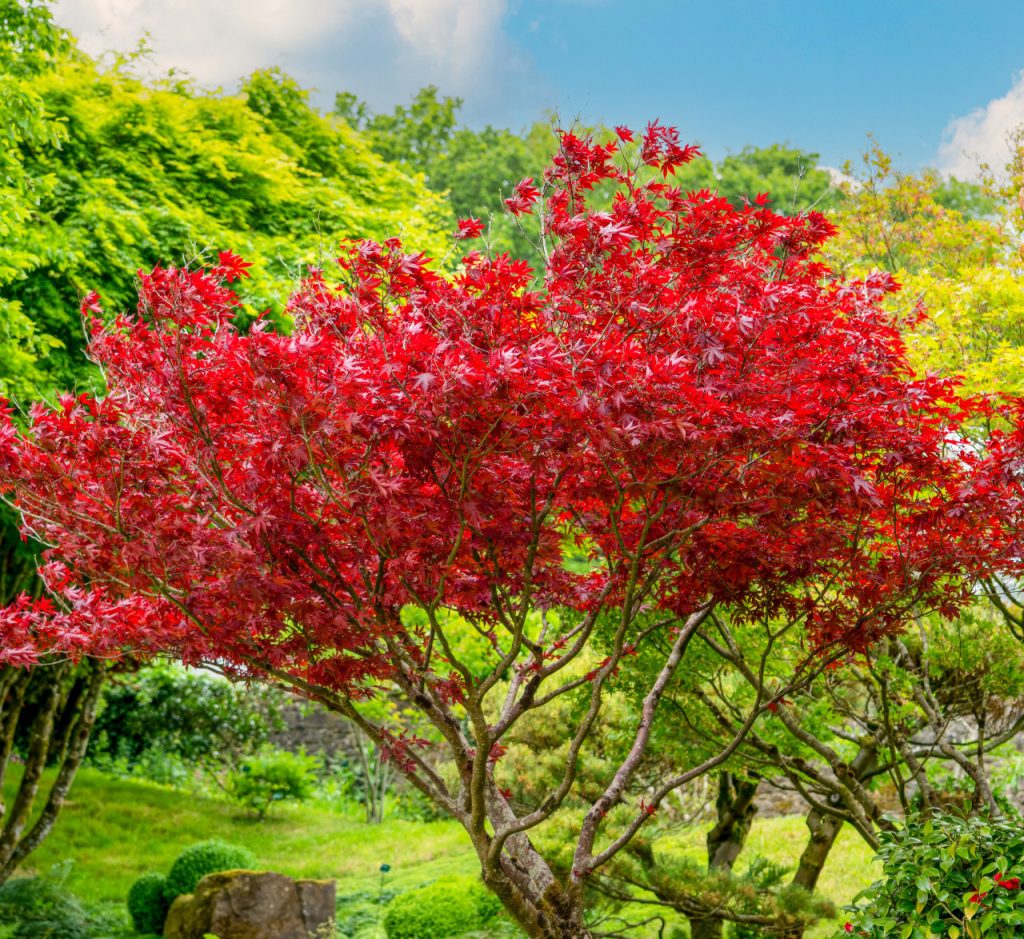
2. Cherry Tree (Prunus Serrulata)
The Cherry Tree is another well-known tree from Japan. It is the national tree of Japan, and its blossoms are a symbol of spring. It is a stunning ornamental tree renowned for its breathtaking spring blossoms and delicious fruit. Cherry Trees are members of the Rosaceae family and encompass various species and cultivars, including Prunus avium (sweet cherry) and Prunus serrulata (flowering cherry).
These trees typically feature a graceful, spreading canopy adorned with clusters of fragrant, pink or white flowers in early spring, creating a spectacular display of color and fragrance. The leaves of Cherry Trees are oval-shaped and often emerge in shades of green, turning vibrant hues of yellow, orange, or red in the fall. Depending on the species and cultivar, Cherry Trees can reach heights ranging from 20 to 30 feet, though some may grow taller or remain more compact.
Cherry Trees have a rich history dating back centuries, with origins in regions across Europe, Asia, and North America. Revered for their beauty and cultural significance, Cherry Trees have been celebrated in art, literature, and folklore for generations. The introduction of Cherry Trees to the United States is attributed to various sources and periods. In the early 17th century, European colonists brought cherry seeds and saplings to North America, establishing orchards and gardens in colonial settlements.
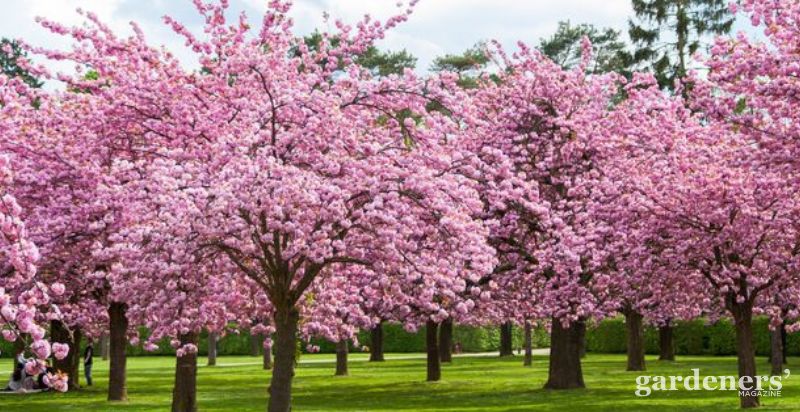
3. Sakura (Prunus Serrulata ‘Kanzan’)
The Sakura is a variety of cherry tree that is particularly well-known for their beautiful pink blossoms. Sakura means “cherry blossom” in Japanese, and these trees are treasured for their short but stunning blooming period. Belonging to the Rosaceae family, the Sakura ‘Kanzan’ boasts a graceful, upright form adorned with clusters of double-petaled, vibrant pink flowers in early spring.
These blossoms create a breathtaking display of color and fragrance, attracting admirers and pollinators alike. The foliage of the Sakura ‘Kanzan’ consists of ovate, serrated leaves that emerge in shades of green, turning golden-yellow in the fall before shedding for winter. This cultivar typically reaches heights of 20 to 25 feet, with a spread of 15 to 20 feet, forming a stunning focal point in gardens and landscapes.
Originating in Japan, the Sakura ‘Kanzan’ holds a rich cultural significance and has been cultivated for centuries as a symbol of renewal, beauty, and the fleeting nature of life. Its introduction to the United States is attributed to various sources and time periods, with the first documented planting recorded in the late 19th century. However, it gained widespread popularity following the gift of Japanese Cherry Trees, including ‘Kanzan’, from the Mayor of Tokyo to Washington, D.C., in 1912.

4. Ginkgo Tree (Ginkgo biloba)
Ginkgo Tree (Ginkgo biloba), a unique and ancient species known for its distinctive fan-shaped leaves and remarkable resilience. Belonging to the Ginkgoaceae family, the Ginkgo Tree showcases a striking appearance with its fan-shaped, leathery leaves that turn vibrant shades of yellow in the fall before gracefully cascading to the ground. This deciduous tree typically reaches heights of 50 to 80 feet, with a spread of 30 to 40 feet, forming a majestic canopy that provides shade and beauty to landscapes.
Originating from China, the Ginkgo Tree has a rich history dating back millions of years, making it one of the oldest living tree species on Earth. Renowned for its resilience to pests, diseases, and environmental stressors, the Ginkgo Tree has endured through geological ages and cultural shifts.
The ginkgo tree is often planted in Buddhist temples and shrines in Japan and is a common sight in Japanese gardens. The fruits of the ginkgo tree are not edible for humans but are eaten by birds, and the leaves are sometimes used in traditional Chinese medicine.
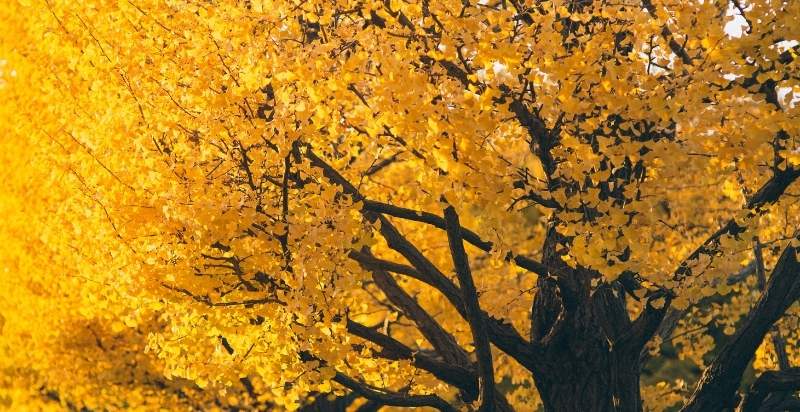
5. Chamaecyparis Obtusa ‘Nana’ (Hinoki Cypress)
I’m drawn to the Chamaecyparis obtusa ‘Nana’, commonly known as the Hinoki Cypress, a graceful evergreen tree renowned for its compact size and elegant foliage. Belonging to the Cupressaceae family, the Hinoki Cypress ‘Nana’ features dense, flattened sprays of dark green foliage that form a compact, pyramidal shape. This dwarf cultivar typically grows to a height of 3 to 6 feet, with a spread of 4 to 8 feet, making it an ideal choice for small gardens, rockeries, or container planting.
Originating from Japan, the Hinoki Cypress has a rich cultural history and has been revered for centuries for its timber, which was used in the construction of temples, shrines, and traditional Japanese architecture. The introduction of the Hinoki Cypress ‘Nana’ to the United States is attributed to plant collectors and horticulturists in the late 19th and early 20th centuries.
Today, the Hinoki Cypress ‘Nana’ is cherished for its beauty, versatility, and cultural significance in gardens and landscapes worldwide.
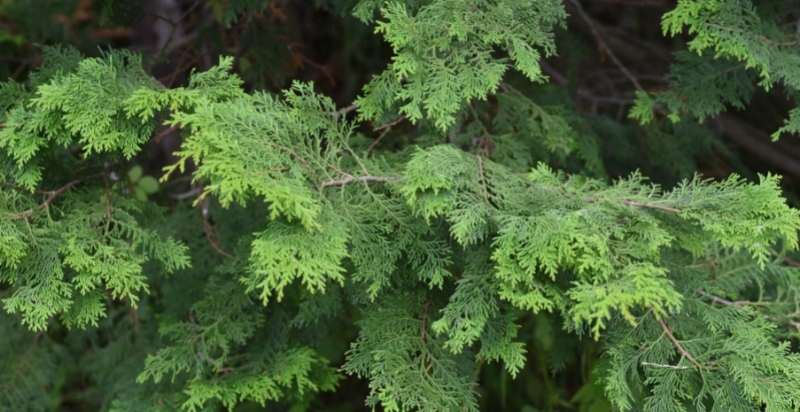
6. Japanese Black Pine (Pinus Thunbergii)
The Japanese Black Pine (Pinus thunbergii) is a striking evergreen tree prized for its rugged beauty and adaptability. Belonging to the Pinaceae family, the Japanese Black Pine boasts a distinctive appearance with its dark green, needle-like foliage and rugged, irregularly shaped trunk. This hardy tree typically reaches heights of 20 to 60 feet, with a spread of 20 to 35 feet, forming a broad, spreading canopy that provides shade and visual interest in landscapes.
Originating from Japan and Korea, the Japanese Black Pine holds cultural significance and has been cultivated for centuries in traditional Japanese gardens and landscapes. Revered for its resilience to harsh coastal conditions and its ability to thrive in poor soils, the Japanese Black Pine has become a symbol of strength and endurance.
Its introduction to the United States dates back to the late 19th century, when it was brought over by plant collectors and horticulturists. Since then, it has gained popularity as an ornamental tree and is commonly planted in coastal regions.

7. Bonsai Tree
The Bonsai Tree, scientifically referred to as various species of trees trained to grow in miniature form, represents a captivating art form and horticultural practice. Its appearance varies greatly depending on the species used but typically features a small, aesthetically pruned tree growing in a shallow container. Bonsai trees can range from just a few inches to several feet in height, with their compact size enhancing their beauty and elegance.
Originating in China over a thousand years ago and later adopted by Japanese artisans, the art of bonsai involves meticulous pruning, wiring, and training to create miniature replicas of full-sized trees. This ancient tradition reflects principles of harmony, balance, and respect for nature. Bonsai cultivation eventually spread to other parts of the world, including the United States, where it gained popularity among enthusiasts and hobbyists in the early 20th century.
The introduction of bonsai to the United States is attributed to exhibitions and demonstrations held at international expositions and world fairs, such as the 1915 Panama-Pacific Exposition in San Francisco. Since then, bonsai cultivation has flourished in the USA, with dedicated clubs, workshops, and exhibitions showcasing the beauty and artistry of these miniature trees. Today, bonsai remains a cherished art form and hobby, celebrated for its timeless beauty and cultural significance. Bonsai can live for many years; some specimens are over 100 years old.

8. Japanese Holly (Ilex crenata)
The Japanese holly, scientifically known as Ilex crenata, is a versatile evergreen shrub celebrated for its glossy foliage and ornamental berries. Belonging to the Aquifoliaceae family, the Japanese Holly typically features small, dark green leaves with serrated edges, giving it a distinctive appearance similar to traditional holly species. This compact shrub can vary in height, ranging from 3 to 10 feet, depending on the cultivar and growing conditions, making it suitable for a variety of landscape settings.
Originating from East Asia, including Japan, Korea, and China, the Japanese Holly has a rich cultural history and has been cultivated for centuries in traditional gardens and landscapes. Revered for its resilience, adaptability, and low maintenance requirements, the Japanese Holly has become a popular choice among gardeners and landscapers worldwide.
The introduction of the Japanese Holly to the United States is attributed to plant collectors and horticulturists in the late 19th and early 20th centuries. Since then, it has gained popularity as an ornamental shrub, valued for its glossy foliage, attractive berries, and tolerance to various growing conditions. Today, the Japanese Holly remains a cherished addition to gardens, parks, and landscapes, admired for its beauty and versatility.
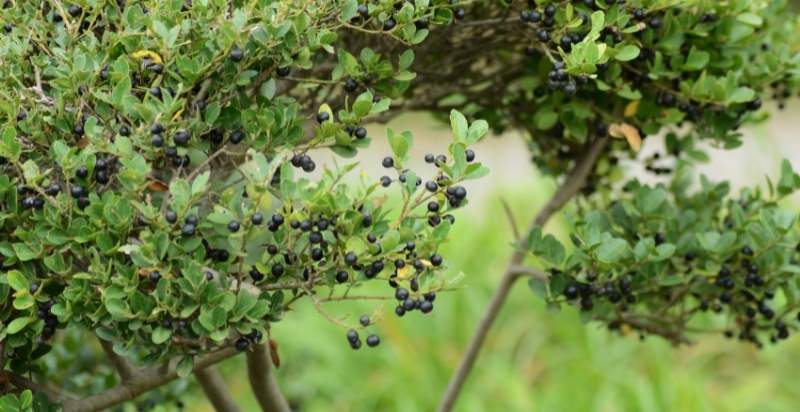
9. Japanese Wisteria (Wisteria Floribunda)
The Japanese Wisteria, scientifically known as Wisteria floribunda, is a breathtaking flowering vine admired for its cascading clusters of fragrant blooms and lush foliage. Belonging to the Fabaceae family, it produces beautiful purple flowers hanging down from its branches like lavender-colored cascades.
The foliage consists of compound, pinnate leaves that emerge after the flowers, providing a verdant backdrop to the spectacular floral display. Japanese Wisteria can climb to impressive heights, often reaching 25 to 30 feet or more when supported by a sturdy structure or tree.
Originating from Japan, the Japanese Wisteria has a rich cultural history and has been cultivated for centuries in traditional gardens, temples, and arboretums. Its introduction to the United States is attributed to plant collectors and horticulturists in the mid-19th century. Since then, it has gained popularity as an ornamental vine, treasured for its stunning flowers and graceful, cascading habit.
Today, Japanese Wisteria remains a beloved choice for arbors, pergolas, and garden trellises. It enchants observers with its captivating beauty and intoxicating fragrance.
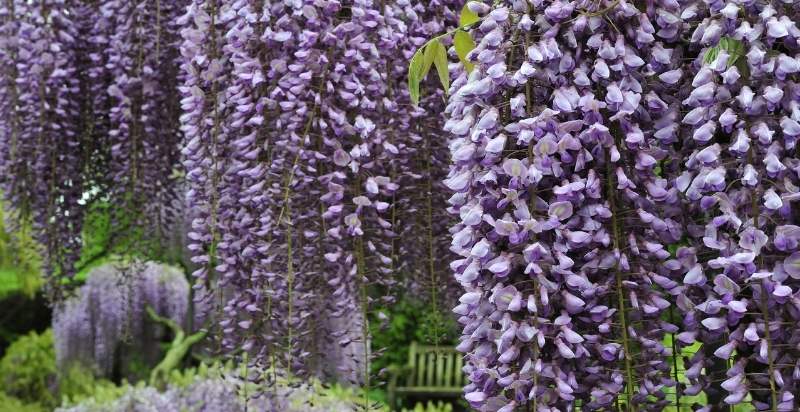
10. Japanese Pagoda Tree (Styphnolobium Japonicum)
The Japanese Pagoda Tree, scientifically named Styphnolobium japonicum, is an elegant deciduous tree esteemed for its graceful form and ornamental qualities. Belonging to the Fabaceae family, it showcases compound leaves comprised of small leaflets that emerge in late spring and turn a vibrant yellow hue in the fall. Its fragrant, creamy-white flowers bloom in pendulous clusters, adding to its visual allure. The tree typically reaches heights of 30 to 50 feet, with a spread of 25 to 35 feet, forming a broad, rounded canopy.
Originating from East Asia, including Japan and China, the Japanese Pagoda Tree holds cultural significance and has been revered for centuries for its beauty and symbolism. Its introduction to the United States dates back to the late 18th century when it was brought over by early plant collectors and botanists. Since then, it has become a popular ornamental tree in American landscapes, valued for its graceful silhouette, attractive foliage, and tolerance to urban conditions.
Today, the Japanese Pagoda Tree continues to enchant gardeners and observers with its charming presence and cultural heritage.
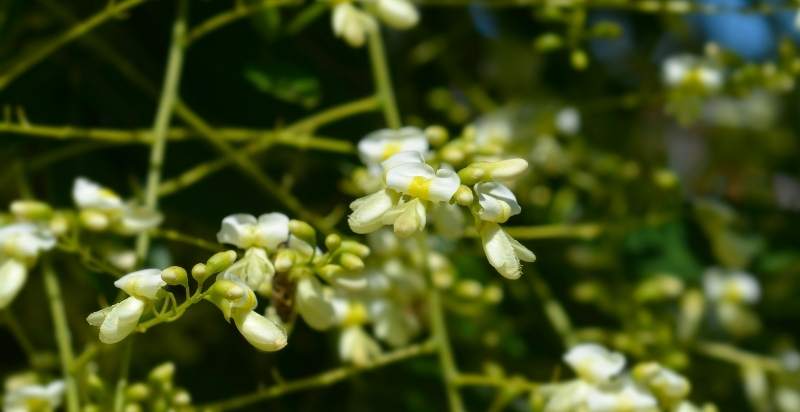
11. Japanese Cedar (Cryptomeria Japonica)
The Japanese Cedar, scientifically known as Cryptomeria japonica, is a majestic evergreen conifer revered for its stately appearance and cultural significance. Belonging to the Cupressaceae family, it features needle-like foliage arranged in dense clusters that create a pyramidal or conical shape. The foliage ranges in color from deep green to bluish-green, providing year-round beauty to landscapes. Japanese Cedars can reach impressive heights, towering up to 50 to 70 feet, with some specimens exceeding 100 feet in optimal conditions.
Originating from Japan and parts of China, the Japanese Cedar holds a rich history dating back centuries and has been revered in Japanese culture as a sacred and symbolic tree. Its introduction to the United States occurred in the mid-19th century when it was brought over by plant collectors and horticulturists.
Since then, it has become a popular ornamental tree in American landscapes, prized for its elegant form, lush foliage, and tolerance to a wide range of growing conditions. Today, the Japanese Cedar continues to be cherished for its beauty, resilience, and cultural significance in gardens and parks across the country.
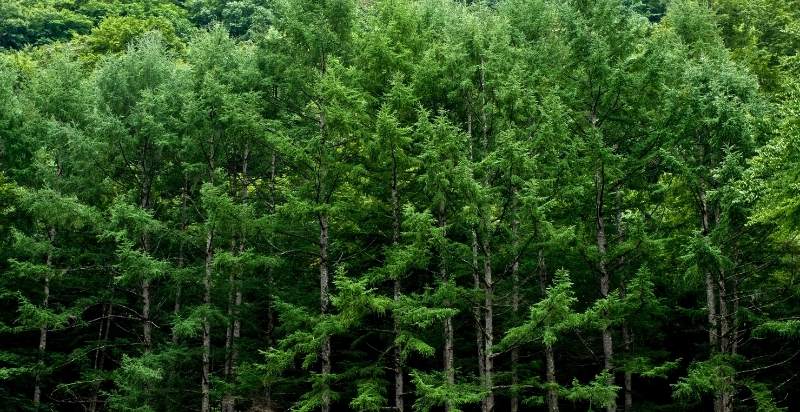
12. Japanese Cypress (Chamaecyparis Obtusa)
The Japanese Cypress, also known as Chamaecyparis obtusa, is a stunning evergreen tree loved for its elegant shape and lovely fragrance. Its foliage is like soft, green scales that give it a lush and inviting look. With its branches gently drooping, it forms a beautiful pyramid or cone shape. These amazing trees can grow pretty tall, reaching 50 to 70 feet, sometimes even taller!
Originally from Japan, the Japanese Cypress has been cherished for centuries in Japanese culture. It’s been used in building temples, crafting beautiful gardens, and more, thanks to its strong and fragrant wood. It made its way to the United States in the late 1800s, brought over by plant enthusiasts and garden lovers. Since then, it’s become a favorite in American gardens for its beauty and significance. People love having these trees around for their graceful appearance and constant greenery.
They truly add a touch of elegance to any landscape!

13. Japanese Apricot (Prunus Mume)
The Japanese Apricot, or Prunus mume, is a wonderful flowering tree loved for its early spring blossoms and sweet fragrance. It’s like a little burst of joy in late winter, with its pink or white flowers blooming before the leaves even come out. These trees usually grow to about 15 to 25 feet tall and have a nice, rounded shape.
Originally from China, Korea, and Japan, the Japanese Apricot has been treasured for thousands of years. It’s got a special place in East Asian culture, symbolizing things like new beginnings and the beauty of spring. People have been enjoying its lovely blooms for centuries! In the United States, it first arrived in the 1800s, thanks to plant lovers and explorers who brought it over. Since then, it’s become a favorite in American gardens, adding a touch of early spring magic with its delicate flowers and rich history.
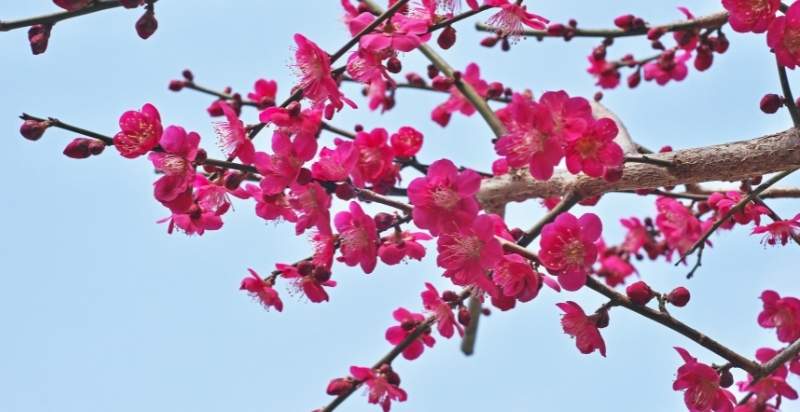
14. Japanese Umbrella Pine (Sciadopitys Verticillata)
The Japanese Umbrella Pine, also known as Sciadopitys verticillata, is a fascinating and unique evergreen tree loved for its striking appearance and unusual foliage. It’s like having a little piece of ancient Japan right in your garden! With its whorls of dark green, needle-like leaves arranged in umbrella-like clusters, this tree has a distinctive and charming look. Plus, it stays green all year round, bringing a splash of color to your landscape even in the winter.
These trees can grow to be pretty tall, reaching heights of around 30 to 50 feet, and they have a lovely, pyramidal shape that adds a touch of elegance to any garden.
Originally from Japan, the Japanese Umbrella Pine has a long history dating back thousands of years. It’s been admired for its beauty and resilience by gardeners and nature lovers for centuries.

When is the Best Time to visit Japan to see most of the Trees Blooming?
The best time to visit Japan to see most of the trees blooming is during the spring season, typically from late March to early May. This period is known as “sakura” or cherry blossom season, and it’s when the country bursts into a stunning display of pink and white blooms.
Cherry blossoms are the most iconic, but many other trees, such as plum, peach, and magnolia, also bloom during this time, creating a colorful tapestry across the landscape.
The exact timing of the bloom varies depending on the location and weather conditions, so it’s a good idea to check the cherry blossom forecast, known as “sakura-Jensen,” before planning your trip. Additionally, different regions of Japan experience peak bloom at different times, so you may be able to catch the cherry blossoms in one area even if you miss them in another.
Overall, spring is a magical time to visit Japan, as you can experience not only the beauty of the cherry blossoms but also the vibrant culture and traditions associated with hanami, flower viewing, and festivals.
Conclusion
With such a wide variety of flora, Japan is a paradise for plant lovers. Some gardens and parks offer stunning views of the country’s diverse vegetation. Spring is the best time to see the cherry blossoms in full bloom, while autumn offers gorgeous views of leaves changing color. No matter what time of year you visit, there will always be something beautiful to see.
- Water Berries: Description, Flavor, Benefits, And Uses - June 18, 2024
- Everything You Wanted To Know About Sweetheart Cherries - June 17, 2024
- Indian Jujube: Description, Flavor, Benefits, And Uses - April 30, 2024
